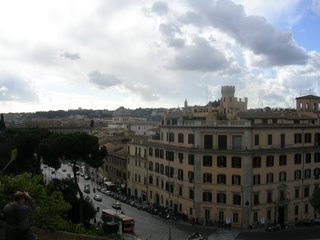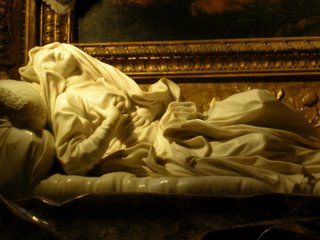I remember that my arms ached for days, even after the painting was finished. It felt like such an awkward posture, my elbows splayed out to either side like that, my shoulders hunched. I pictured myself looking like some sort of discomfited bird posed like that, my puffy sleeves of blue taking on the look of over-bright plumage. But of course one should never question the artist, even an artist so new in the art world as Caravaggio. He was overly forceful, even rude, to those in his employ, but they all obeyed his wishes without question. Why should you question the decisions of a man whose painted figures always came out looking just how he wished them to? He chose his models, seemingly at random, off the streets of Rome and they always came out looking just as graceful, awkward, young, old, beautiful or ugly as he wished them to. He had noticed me when I was only fourteen years old, a wild boy, free in a wild city, and had pulled me from my nightly prowls to pose as his Narcissus. He said it was because of my extraordinarily pristine features, but I think perhaps he had other reasons as well. There were a hundred youths in Rome with features just as fine as my own that he could have sought out. I think perhaps he sought me in particular because he knew of my childish exploits. I believe he had observed me in my pursuits of the beautiful daughter of the local backer, whose shop was visible from the window of his studio. I loitered secretly outside the shop quite often, gazing through the window at the girl of my fancy. I did not suspect that he had seen me at my game until it came time for him to sketch in the expression on the face of Narcissus. When I came in that morning to take up my usual, awkward position on the floor, Caravaggio announced that I would have to hold not only my position but my expression. He told me to look at the floor as though I were in love with it, but the expression that resulted proved to be, in his words, “wretchedly unsuccessful.” Hurt, I suggested that perhaps another model would be able to live up to his wishes rather better, to which he replied that he knew I could make the face he wanted if under the correct influence. He snatched a blank sheaf of paper off one of the cluttered tables in the room and with his pen sketched furiously for a mere thirty seconds, then put what he had drawn on the floor where my gaze should fall when in my Narcissus pose. I looked down to study this new addition to my environment and found a perfect drawing of the baker’s daughter. I was transfixed by the perfection of the artist’s rendition of my love interest for the few minutes needed to draw in the features of his Narcissus.
When I was allowed to see the painting some weeks later, I was first made to giggle by the foolish look of adoration that was seen as if in double vision on Narcissus’ face and that of his reflection. My mirth stopped abruptly, though, when I noticed the closeness of the action to come. Caravaggio had painted the small moment right before Narcissus drowns in the pool bearing his beloved reflection, and though the expression of the boy in the painting was foolish, I could see that the thing about to happen was not something to cause laughter. The black background forced the boy, an eerie vision of myself, into the room with me, and at the same time obliterated any hope of salvation from his obvious fate. I still felt the laughter of the moment within me, but also the fear of the moment to come. Such was my first experience with the master of captured emotions and captured moments.
Although Caravaggio often used the same models over and over again, it was many years before he chose to use me in another painting. Actually, it was unusual that I should have seen him again because of his banishment from Rome. Having been a fan of his work ever since I had posed for him as a child, though, I went to give him my regards when I was in Naples on business. He appeared very different from when I had last seen him so long ago, but he greeted me warmly and had me pose briefly as one of the three tormenters in the large painting of the Flagellation he was working on to be the altarpiece in a church. He was putting the finishing touches on the arms of the man on the left, and so I stood and chatted with him a bit while holding my arms outstretched with my muscles strained for almost an hour. Through our conversation I thought there were hints of distress at being away from Rome, of being in exile that I had imagined were also in his face. He allowed me to see the almost finished painting before I left, and seeing that the only thing left to complete was the face of Christ, I asked if he knew who he would be using to model for the expression of Jesus Himself. He told me that although the awful expressions of the tormenters were from life, he would need no model for Christ.
A few years later when I was back again in Naples, I made a point to visit the church where Caravaggio’s Flagellation was displayed, and I saw immediately why he had needed no model. Christ’s face was showing a nearly indescribable emotion as he twisted out of the darkness surrounded by the men who would commit the act. Again he had chosen to show the moment right before the action, and the image was startling, but what caught my attention most was the face of Christ. I saw immediately why he had needed no model. The face was perfect, as it should be for such a subject, but what was portrayed was more an emotion than a describable expression. Although it was not a self portrait, and the expression was not even fully visible, I knew Caravaggio had used his own emotions as inspiration. There was a power there that could not come from mere observation of pain. It could only come from the loss of something as beautiful as the compassion of men, as vital as the city of Roma.






